AMAZON multi-meters discounts AMAZON oscilloscope discounts
OBJECTIVES
After studying this unit, the learner/learner will be able to use the National Electrical Code to determine the requirements and limitations of transformer installations.
The National Electrical Code (NEC) covers the minimum requirements of the installation of electrical wiring and equipment within public or private buildings and their premises.
TRANSFORMER LOCATION
The location of transformers is a prime Code ruling. Most electrical codes and power companies state that transformers and transformer vaults must be readily accessible to qualified personnel for inspection and maintenance. The codes also contain specific sections covering oil-insulated, askarel-insulated, other dielectric fluids, and dry-type transformers, as well as transformer vaults. Dry-type transformers installed outdoors should have weather-proof enclosures.
TRANSFORMER OVERCURRENT PROTECTION
The National Electrical Code gives information on the overcurrent protection required for transformers and transformer banks, as well as the maximum overcurrent protection allowed on the primary of a transformer.

ill. 1 Transformer overcurrent protection
ill 1 illustrates where transformer primary protection is located.
For a transformer 600 volts or less, overcurrent protection is permitted in the secondary in place of primary protection provided that certain regulations are followed.
1. The secondary overcurrent protection. Must not be greater than 125 percent of the rated current of the secondary.
2. The primary feeder must not have overcurrent protection in excess of six times the rated primary current of the transformer. This is allowable only when the percentage impedance of the transformer isn't in excess of 6 percent.
3. If the percentage impedance is greater than 6 percent but less than 10 percent, the primary feeder must not be rated in excess of four times the rated primary current of the transformer.
About 90 percent of the transformers used within buildings are the dry type and generally require lower values of overcurrent protection. Consult Section 450-3 of the National Electrical Code for specific information as to the value of the protection.
ill 2 illustrates a transformer connection where the overcurrent protection is inserted in the secondary circuit. Note that the only primary protection is the feeder over- current protection.
A transformer with integral thermal overload protection (the protection is built into the transformer) does not need primary fuse protection. However, there must be primary feeder protection. The feeder overcurrent rating requirements are the same as given previously.
The Code requires that instrument potential transformers have primary fuses. Fuses of different sizes are required for operation above and below 600 volts.
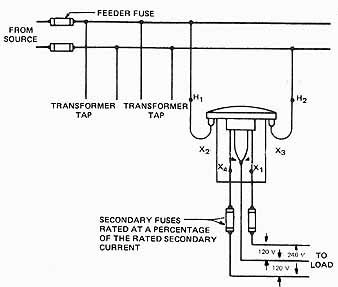
ill. 2 Transformer and feeder overcurrent protection.
SECONDARY CONNECTIONS BETWEEN TRANSFORMERS
The Code defines a secondary tie as a circuit operating at 600 volts or less between phases. This circuit connects two power sources or power supply points such as the secondaries of two transformers.
A secondary tie circuit should have overcurrent protection at each end except in situations as described in the Code. A tie connection between two transformer secondaries is illustrated in 3. Note that the tie conductor circuit has overcurrent protection at each end and that there are no load taps in the tie connections.
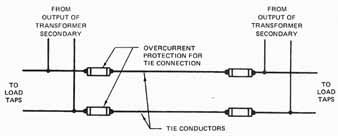
ill. 3 Tie connections between transformers
However, when load taps are made in the tie circuit between transformers, the minimum size of conductor required is regulated by the Code. In this case, the current-carrying capacity shall not be less than a stipulated percentage of the rated secondary current of the largest capacity transformer connected to the secondary tie.
A tie connection (with load taps) between two transformer secondaries is illustrated in 4, Since there are load taps present, the size of the tie conductors must be increased.
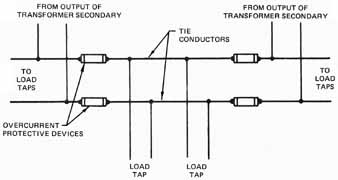
ill. 4 Tie connections between transformers with load taps
The overload protective devices used for the tie connection with load taps must be approved by the Underwriters’ Laboratories, Inc. (UL). The following, when approved, are acceptable for protection:
• limiting devices consisting of fusible-line cable connectors (limiter);
• automatic circuit breakers.
If the voltage exceeds a value specified in the Code, the tie conductors must have a switch at each end of the tie circuit. When these switches are open, the limiters and tie conductors are deenergized. These switches shall be not less than the current rating of the tie conductors. Further, these switches shall be capable of opening their rated current.
The Code gives further information on overcurrent protection where secondary tie connections are used. It is acceptable practice to provide overcurrent protection in the secondary connections of each transformer. The setting of this overcurrent device is regulated by the Code.
An automatic circuit breaker must be installed in the secondary connection of each transformer. This circuit breaker must have a reverse-current relay set to open the circuit at not more than the rated secondary current of the transformer.
PARALLEL OPERATION OF TRANSFORMERS
Transformers may be operated in parallel and protected as a unit if their electrical characteristics are similar. These electrical characteristics include the voltage ratio and the percentage impedance. When transformers have similar electrical characteristics, they will divide the load in proportion to their kVA rating.
GUARDING OF TRANSFORMERS
Appropriate provisions must be made to minimize the possibility of damage to transformers from external causes. This is particularly important if the transformers are located where they are exposed to mechanical injury.
Dry-type transformers must be provided with a noncombustible moisture-resistant case or enclosure which will provide reasonable protection against the accidental insertion of foreign objects. They also should have weatherproof enclosures when installed outdoors. The transformer installation must conform with the Code provisions for the guarding of live parts.
The operating voltage of exposed live parts of transformers must be marked by warning signs or visible markings. These markings or signs are to be mounted in unobstructed positions on the equipment and structure.
GROUNDING
The National Electrical Code requires that the metal cases and tanks of transformers be grounded. Further, all noncurrent-carrying metal parts of transformer installations and structures, including fences, are also to be grounded. This grounding must be done in the manner prescribed by the Code to minimize any voltage hazard that may be caused by insulation failures or static conditions.
TRANSFORMER NAMEPLATE DATA
According to the Code, each transformer shall be provided with a nameplate and the nameplate must include the following information:
a manufacturer’s name;
b. rated kVA capacity;
c. frequency in hertz;
d. primary and secondary voltages;
e. amount of insulating liquid and type used;
f. temperature class of insulation should be indicated on the nameplate in dry-type transformers;
g. temperature rise for this insulation system;
h. impedance (25 kVA and greater);
i. required clearances for transformers with vented openings.
DRY-TYPE TRANSFORMERS INSTALLED INDOORS
Dry-type transformers are used extensively for indoor installations. These transformers are insulated and cooled by air. They are not encased in the steel tanks required for oil-filled transformers. For protection, dry-type transformers are enclosed in sheet metal cases with openings to allow air to circulate.
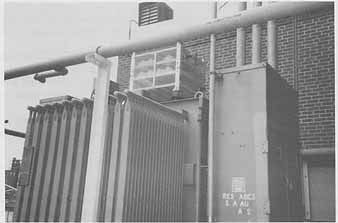
ill. 5 Oil filled transformers with radiator cooling fins
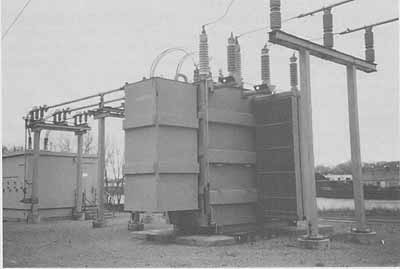
ill. 6 Oil insulated transformer used at a substation
The Code specifies that dry-type transformers of a 112 1/2-kVA rating or less must have a separation of 12 inches from any combustible material. However, there are Code conditions and exceptions.
Some transformers of more than a specific rating must be installed in a transformer room with fire-resistant construction or must be installed in a transformer vault. Transformers with Class B insulation (80°C temperature rise) or Class H insulation (150°C temperature rise) need not be installed in a transformer vault provided they are separated from combustible material by the horizontal and vertical dimensions specified in the Code, or are separated from combustible material by a fire-resistant barrier. Any dry-type transformer rated at more than 35,000 volts must be installed in a transformer vault.
ASKAREL-INSULATED TRANSFORMERS INSTALLED INDOORS
The windings of some transformers are cooled and insulated by a synthetic, non flammable liquid called as/care!. Askarel, when decomposed by an electric arc, produces only nonexplosive gases.
The Code specifies that askarel-insulated transformers over 25 kVA must be fur nished with a pressure-relief vent. If this type of transformer is installed in a poorly ventilated area, it must be furnished with some method of absorbing gases that may be generated by arcing inside the case.
Any askarel-insulated transformer rated over 35,000 volts must be installed in a vault.
OIL-INSULATED TRANSFORMERS INSTALLED INDOORS
Many transformers are cooled and insulated with a special insulating oil. The fire hazard potential due to oil-insulated transformers is greater than that of askarel-insulated transformers therefore; the Code requirements are more exacting for oil-insulated transformers.
OIL-INSULATED TRANSFORMERS INSTALLED OUTDOORS
The Code requires that combustible buildings, door and window openings, and fire escapes must be safeguarded from fires originating in oil-insulated transformers. Such protection may be provided by effective space separation or by erecting a fire-resistant barrier between the transformer bank and the areas requiring protection.
In addition, the Code requires that some means be installed to contain and remove the transformer oil from a ruptured transformer tank. Such a precaution applies to a transformer installation adjacent to a building where an oil explosion can result in a fire hazard without this preventive measure.
PROVISIONS FOR TRANSFORMER VAULTS
The Code regulations cover all essential details for vaults used for transformer installations, including the arrangement, construction, and ventilation of the vaults.

ill. 7 Approved use of an autotransformer
AUTOTRANSFORMERS
Code specifications are given for the use of autotransformers for lighting circuits. Recall that an autotransformer does not have separate primary and secondary windings. It consists of only one winding on an iron core. Part of the single winding of the autotransformer is common to both the primary and secondary circuits.
The Code limits the use of an autotransformer to feeding branch circuits because of the interconnection of the primary and secondary windings. The autotransformer may be used only where the identified ground wire of the load circuit's connected solidly to the ground wire of the source (NEC Section 210-9).
ill 7 illustrates an autotransformer connected to a lighting load. Note that the ground wire is carried through the entire system.
An alternate use of an autotransformer for lighting circuits is illustrated in 8. This circuit also follows Code regulations as the identified ground wire is carried through the entire system.
ill 9 illustrates an application for an autotransformer which is NOT approved by the Code. Here, the single-phase, 230-volt input to the autotransformer is obtained from a three-phase, 230-volt source. The use of a mid-tap on the autotransformer makes available a single-phase, three-wire system for a lighting load. However, if the ground wire isn't solidly connected through the entire system, this circuit won't meet Code regulations. The type of installation illustrated in 9 is unsafe, particularly if an accidental ground condition develops on the three-phase system.

ill. 8 Approved use of an autotransformer
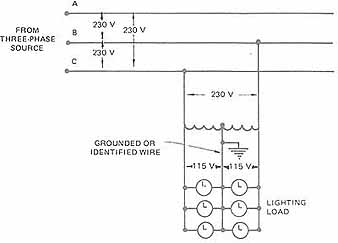
ill. 9 Incorrect use of an autotransformer

ill. 10 Voltage regulator transformer (Westinghouse Electric and Manufacturing Company)
“Buck” and “Boost” Transformers

ill. 11 Transformer used for buck or boost application
Autotransformers are also used where only a small voltage increase (boost) or decrease (buck) is required. An example is to operate a 230-volt appliance from a 208-volt feeder line. This is accomplished by the use of an autotransformer which increases the 208-volt feeder line voltage to the 230 volts required to operate the appliance. Voltage drops (losses) in long or heavily loaded distribution systems may be increased in this manner as an energy conservation measure. Many regular (isolating) transformer corrections are used as autotransformers to decrease or increase a voltage.
ill. 12 (above right) Four-wire delta secondary identification
IDENTIFIED FEEDER
On a four-wire, delta-connected secondary feeder conductor where the midpoint of one phase is grounded to supply lighting and similar loads, the phase conductor with the highest voltage to ground must be identified by an outer finish that's orange in color, or by tagging,. This identification is to be placed at any point where a connection is made if the neutral conductor is also present, such as in a distribution panel, junction box, or pull box.
SUMMARY
Transformers must be installed according to the provisions of the National Electrical Code. There are many provisions that apply and each case must be thoroughly researched. When using the Code criteria, be sure to consider all the provisions of the Code. Overcurrent protection can be quite different depending on the location and other protection avail able at the transformer installation. Be sure to consider the nameplate information when locating the transformer. Transformers can be quite dangerous and may cause severe injury or property damage if not installed and protected properly.
QUIZ
1. The rated primary current of a transformer is 4 amperes at 480 volts. How is the permissible maximum current setting determined for the overload devices used on the primary side of the transformer when secondary overcurrent protection is omitted?
2. The Code permits overcurrent protection in the secondary in place of the primary protection if two requirements for transformers 600 volts or less are observed. What are these requirements?
a.
b.
3. What items of data should appear on a transformer nameplate to comply with Code requirements?
4. What is a secondary tie circuit?
5. What happens to the secondary tie conductor size if loads are connected to the tie conductors?
6. What overload devices are acceptable to protect a secondary tie connection with load taps?
7. What are the electrical characteristics that must be similar if transformers are to be operated in parallel?
8. What are the Code requirements for the grounding of transformer installations?
9. How is the load divided when transformers are operated in parallel and protected as one unit?
10. What precaution must be observed in using autotransformers to supply lighting circuits which are grounded?
11. Give an example of how an autotransformer is used in a circuit to increase the volt age.
12. Connect the following isolating transformer as an autotransformer to “boost” the voltage from source to load.______
